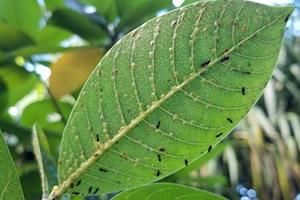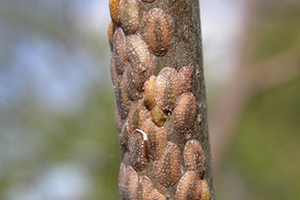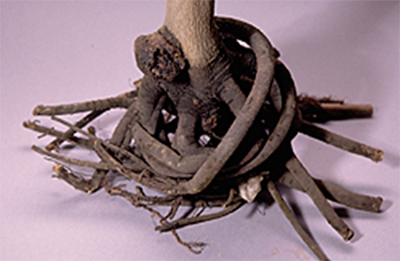Selecting Plants
Common Landscape Pitfalls that Affect Plant Health – Plant Quality Edition
Landscapes with plants that match their preferred growing conditions require less water, fertilizer, pesticides, and maintenance than landscapes with plants growing in the wrong locations. When choosing the right plant for the right place, there are a number of factors to consider to ensure a long-lived, healthy landscape.
In the fourth part of our "Common Landscape Pitfalls" series, we'll show how starting out with quality plants plays a huge role in the long-term well-being of your plants.
Plant Quality
When looking for new plants to add to your landscape, thoroughly inspect your prospects before purchasing them.
Look for signs of pests or disease like holes in leaves, black spots, distorted leaves, blisters, or sticky feeling leaves. Check for hidden insects on the undersides of leaves or camouflaged on stems.


Scale on the underside of a leaf (left) and a stem (right).
Buying infected plants not only hurts the plant you’ve added to your landscape, it can spread the insects and disease to other plants in your garden.
Making sure foliage and roots are healthy. Foliage that is wilted or limp, or leaves that are yellow, brown, or black are not healthy. Additionally leggy plants are generally not the healthiest; opt for plants that are perky and lush with robust, well-branched structure. Roots that are coming out of the pots are also not signs of a healthy plant. You should remove perspective plants from the pot and check for circling or girdled roots; circling roots are indicative of a weak plant that is unlikely to reach its full potential.

Girdled roots.
Other things to consider are if a plant has weeds growing in the pot. The presence of weeds is usually a sign that a plant is not getting the nutrients it needs as it competes with the weeds.
When purchasing blooming plants, select ones that have unopened blooms. Similarly, when you are selecting a fruiting plant, look for one that has a balanced number of fruits or even just a few fruits.
Selecting healthy materials—and then putting them in the right spot—is the first step to landscape success.
Also on Gardening Solutions
- 10 Important Things to Consider When Planning Your Landscape Design
- Common Landscape Pitfalls that Affect Plant Health – Irrigation Edition
- Common Landscape Pitfalls that Affect Plant Health – Plant Placement Edition
- Common Landscape Pitfalls that Affect Plant Health – Soils Edition
- Plant Purpose: Making Your Plants Work for You

